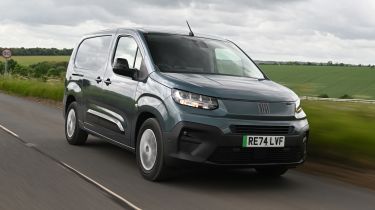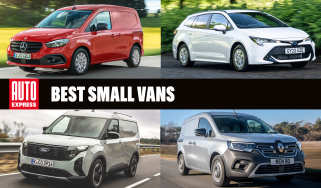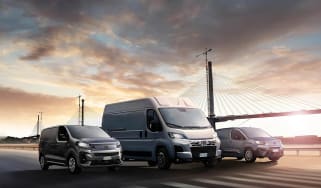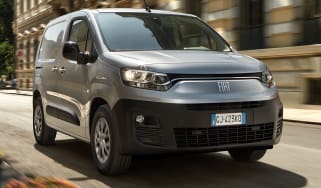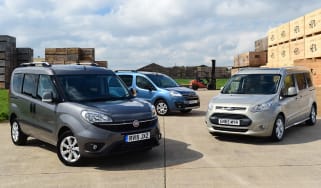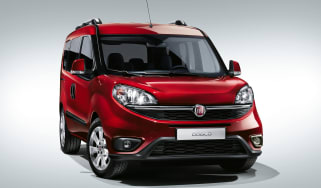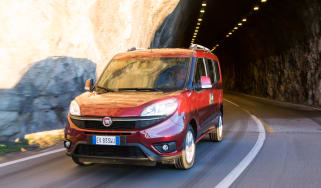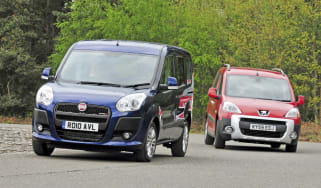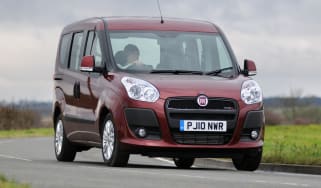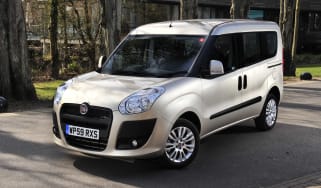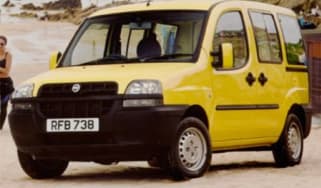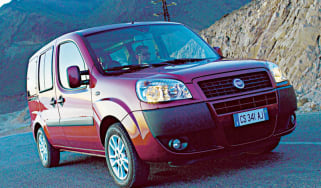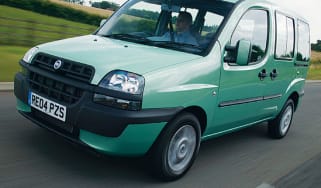Fiat Doblo van review
The Fiat Doblo shares class-leading capabilities with its Citroen Berlingo sibling
Our opinion on the Fiat Doblo
While the Fiat Doblo used to stand out thanks to a somewhat bug-eyed appearance, the latest model is more chiseled and conventional looking. The sister vehicle of Stellantis models like the Citroen Berlingo and Peugeot Partner, the Doblo was recently treated to a minor facelift. It looks a bit fresher as a result, but not a whole lot has changed under the skin.
It remains a competitive choice, with respectable cargo space and payload weights, particularly versus electric rivals. Efficient diesel and electric powertrains also help keep a lid on running costs and the Doblo is a strong all-rounder that’s pleasant to drive.
About the Fiat Doblo
The Fiat Doblo may be the Italian firm’s take on an existing small van, but because that particular van is already a class leader in many disciplines, that's not a bad thing in the slightest.
Sharing technology across multiple models is nothing new, especially in the van sector where the previous generation Fiat Doblo had much in common with the 2012-2018 Vauxhall Combo since GM owned both companies at the time. Fast forward to today, and the vast Stellantis group now owns both Fiat and Vauxhall, so it made sense for both brands to continue their commercial partnership. This time, however, they’re part of an even larger platform sharing scheme with the Citroen Berlingo, Peugeot Partner, Toyota Proace City, Vauxhall Combo and Fiat Doblo all offering very similar packages.
Used - available now

2023 Jaguar
E-PACE
20,543 milesAutomaticDiesel2.0L
Cash £32,500
2021 Hyundai
Ioniq hybrid
14,079 milesAutomaticPetrol1.6L
Cash £17,897
2022 Audi
Q2
49,072 milesAutomaticDiesel2.0L
Cash £17,097
2023 Ford
Puma
22,604 milesAutomaticPetrol1.0L
Cash £16,476It sounds confusing, but it isn’t really. All of these vans share the same silhouette, save for different front bumper designs, minor trim level variations, differing options and aftersales back-up. Externally, the facelifted Doblo has a smooth nose, and Fiat's latest corporate branding, but otherwise looks the spitting image of a Berlingo – even the headlights are the same.
The Fiat Doblo comes in L1, L2 and L2 Crew Van bodystyles, along with a choice between two versions of a 1.5-litre diesel and an electric Fiat E-Doblo version with a 134bhp electric motor and a 52kWh battery mounted under the cargo floor. When you add the through-loading bulkhead (another option available with the Doblo's counterparts), there's up to 4.4 cubic metres of cargo space in the L2 version.
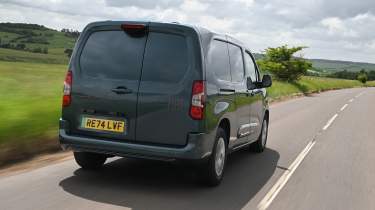
Payload is up to 982kg with certain diesel models, with an additional towing capacity of up to 1,050kg. Even the electric e-Doblo can pull a trailer up to 750kg and carry 781kg in L1 form – that's not far off what's available with the standard Doblo, but with the added benefit of zero-emissions driving.
Respectable fuel consumption and emissions make petrol and diesel Doblos cost-effective vans to run. The electric E-Doblo has a quoted electric driving range of up to 222 miles (although this will vary according to ambient temperature and payload), which is a decent improvement on the range offered by the smaller 50kWh battery of the pre-facelift model. If you have to go farther afield, every version can charge at up to 100kW, meaning you can top up the battery using a high-voltage DC source from 0-80 per cent in half an hour.
Prices start from around £21,000 for the diesel L1 van, and trim levels include the standard ‘Doblo’, Plus and Primo. From the off there’s a Smartphone Station dock on the dashboard, air-conditioning, Bluetooth, electric front windows and rear parking sensors. Plus brings a 10-inch touchscreen and digital instruments along with a load-through bulkhead, while Primo improves the screen sharpness, adds sat-nav and ushers in painted exterior trim.
MPG and running costs
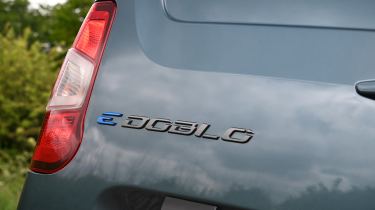
Pros |
Cons |
|
|
Pricing for the standard diesel Fiat Doblo range virtually matches that of the Citroen Berlingo, making it a good value option in the small van class. The electric E-Doblo costs considerably more than the regular diesel model, although the same is true of all its EV van rivals. The upshot is that while it’ll cost more to buy, you’ll recoup that back in saved taxes, servicing and fuel costs – if you avoid lots of pricey rapid charging, along with reduced tariffs for driving in low emissions zones.
Opting for the longer L2 version over the standard L1 adds just under £1,000 to the price, but does get you additional cargo capacity and sliding side doors on both sides of the van.
Fuel economy for the diesel of up to 54.4mpg for the BlueHDi 100 compares well with the Doblo’s closest siblings, and not just those that use the same engines. Fuel economy won’t take a big hit if you pick the Crew Van version, but opting for the more powerful diesel sees consumption increase to 51.9mpg.
Electric range, battery life and charge time
As we’ve already mentioned, all versions of E-Doblo have a WLTP rating of 217 miles on a full charge, which beats the range figure of rivals from Ford and Renault. That’ll go up if you stick to mostly urban routes and select the strongest brake energy regeneration using the paddles behind the steering wheel. This increases the amount of charge that goes back into the battery when you lift off the accelerator to slow down. Conversely, driving at higher speeds will have a noticeable impact on the overall range figure, seeing it drop more quickly.
You can also utilise the Eco mode to improve your range. It pegs power back to 81bhp, limits your top speed and cuts the air conditioning to claw back roughly 10 miles of range – useful if you're getting low on charge and need the extra range. Conversely, select Power mode for the full 136bhp and expect to see roughly 10 miles knocked off your remaining range.
If you’re utilising the E-Doblo’s rapid charging capability, you can top up the battery from 0 to 80 per cent from a 100kW charger in 30 mins. Most businesses will charge up the van during its downtime from a wallbox, in which case a three-phase, 11kWh charger will take five hours to fully charge an empty battery, while a 3.6kWh charger will take 15 hours to achieve the same.
Load Space and Practicality
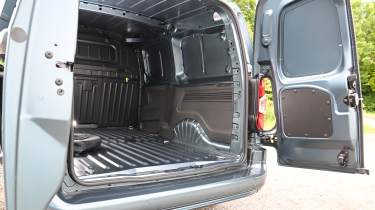
Pros |
Cons |
|
|
Thankfully, whether you go for diesel or the all-electric E-Doblo in L1, L2 or Crew Van body versions, they all have the same amount of room inside. With the option of a load-through bulkhead, the L2 has the greatest cargo capacity with 4.4m3, followed by the L1 at 3.8m3. The addition of rear seats in the Crew Van decreases the capacity to 1.8m3 with the seats in use, or 3.5m3 when they are stowed away.
Payload ratings vary from around 980kg for the entry-level diesel to 642kg for the L2 Crew Van E-Doblo, and compare well with the best in class – even if payload figures have dropped slightly with the latest facelift. The E-Doblo can tow up to 750kg, which does give it a disadvantage versus the 1,050kg capacity of the standard diesel Doblo. It’s also worth noting that the Nissan Townstar EV can tow an even weightier braked 1,500kg trailer.
Access is easy thanks to a rear sill height of 547mm to 569mm, while a width between the wheelarches of 1,229mm means two Europallets can slot inside. The rear aperture is 1,241mm by 1,196mm, while the side door opens to provide a 641mm wide by 1,072mm tall opening.
Reliability, safety and security
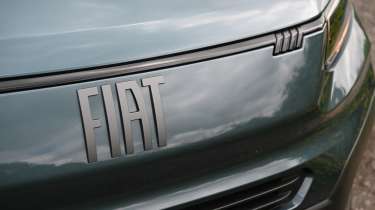
Pros |
Cons |
|
|
Fiat bolstered the Doblo’s safety credentials for its 2024 facelift, making quite a few once optional features standard. These include passenger, side and curtain airbags, along with lane-departure warning technology, driver-attention alerts and speed-limit recognition that’s handy on unfamiliar roads. It’s also worth considering that the Doblo gets a steel bulkhead to keep the cabin safe from dislodged cargo in an accident, where quite a few rivals have a plastic divider.
These improvements helped the Doblo (and its Stellantis twins) get a four-star Euro NCAP commercial van safety rating, but this still places it behind the five-star Mercedes Citan that was found to have superior assistance technology.
All Doblos get a 180-degree reversing camera and a camera-based rear-view mirror so you can see behind you.
With so many parts shared with other Stellantis vans like the Citroen Berlingo, we suspect the Doblo will prove very reliable. Pick the E-Doblo and it should also require less maintenance and servicing thanks to its electric motor.
Security measures include remote central locking with deadlocking and an immobiliser, but a perimetric alarm is only included with Primo trim, or as an optional extra costing around £200.
Driving and performance
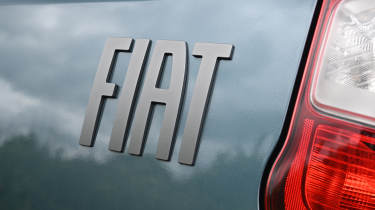
Pros |
Cons |
|
|
The Doblo has the same diesel, and fully electric versions as the Citroen Berlingo. While a petrol option was once offered, the two 1.5-litre BlueHDi diesel engines carried over to the facelift are much better suited to carrying heavy items in the back. Both the 99bhp and 128bhp versions come with a six-speed manual gearbox, with an eight-speed EAT8 automatic transmission reserved for the more powerful BlueHDi engine. The automatic is better than before, with less hesitation when tackling junctions and roundabouts.
The electric motor doesn’t provide as much torque as the most powerful diesel model but, because its power is available immediately, it doesn’t feel any slower when accelerating away from traffic lights. Switching between the Eco, Normal and Power drive modes, as we said earlier, does affect how much power is on tap, with the latter only really required if you’re carrying a heavy payload. Steering wheel paddles replace the 'B' mode on the gear selector, increasing the strength of the regenerative braking system to recover more energy when you slow down over several steps instead of just one. It’s a nice upgrade, but even the strongest setting doesn’t provide ‘one-pedal’ driving.
The E-Doblo handles similarly tidily to diesel versions, plus it leans over less because the mass of the battery pack is located under the floor between the axles, lowering the vehicle’s centre of gravity.
Town driving, visibility and parking
Light steering helps with low-speed driving and parking, and the Doblo has a similarly tight turning circle to the Berlingo, making manoeuvres just that little bit easier than they would be in a Renault Kangoo. The electric E-Doblo is more relaxing to drive than the petrol or diesel models because there are fewer vibrations and a lot less noise entering the cabin.
You’ll also be able to concentrate more on your route without having to deal with distracting gear changes. We’d even say the heavier electric version rides better when unladen compared with the regular Doblo, being a touch more settled over bumps and worn sections of tarmac.
Motorway driving and long-distance comfort
Decent sound deadening helps to make the Doblo a refined place to be on a long motorway drive. There will be a bit of wind noise around the front pillars and the door mirrors, but that’s a criticism of most vans of its type. The 1.5 BlueHDi’s six-speed manual gearbox makes the most of the power on offer, and there's no lack of urge to help haul heavy payloads, but we found the gearbox rather vague when shifting gears.
Cab interior and technology
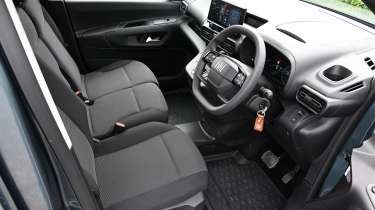
Pros |
Cons |
|
|
The driving position is more upright than you’d find in a regular car due to the standard fit bulkhead behind the front seats. However, even the entry-level Doblo has driver’s seat height adjustment and lumbar controls, along with reach and rake adjustment for the steering wheel.
Big windows and mirrors give a good view out of the front, and you can add a reversing camera to the standard reverse parking sensors to aid reverse parking manoeuvres. A surround-view camera system is also available with the Primo and as part of an option pack for a greater field of vision. If you plan on driving on the motorway a lot, you may want to consider adding blind spot monitoring to warn you of vehicles approaching from the side that you might miss due to the solid bulkhead and considerable blind spot.
There are plenty of places around the Doblo’s interior to store all your work equipment, including an overhead tray and two covered cubbies atop the dashboard. Two cupholders on either side of said dash are big enough for a morning McDonald's coffee cup. The twin passenger seats of the Plus and Primo trim add flexibility, but are a bit narrow compared with the single passenger seat. In particular, the middle passenger won’t have much shoulder room or space for knees where the dashboard protrudes.
The middle seat can also be folded down to create a table, and there’s a lidded cubby above the instrument binnacle. Twin gloveboxes provide enough space for a laptop in the upper compartment, while the lower one is somewhat reduced in size by a fuse box. There are also deep door bins, 12-volt sockets and USB chargers.
Infotainment, sat-nav and stereo
As standard, there’s a Smartphone Station which allows you to dock your personal device and connect via Bluetooth. Plus brings Fiat’s Uconnect infotainment and a 10-inch touchscreen, which is upgraded to a high-definition item with navigation in the Primo trim. We tried the latter, and found it responded pretty quickly and worked well. Physical volume, home and settings shortcuts are also a nice touch, and make it easier to turn off nagging safety settings.
Naturally, there’s standard Apple CarPlay or Android Auto smartphone connectivity should you wish to use your own navigation apps or stream music on the go.
Buying and owning
While we actually found the E-Doblo a bit nicer to drive than the diesel, we suspect the latter will be the more obvious choice for most buyers. For a start, it’s quite a bit cheaper than the electric model, and it’ll probably be offered with more affordable finance deals as a result. More than that, though, it also provides more flexibility to go further afield when the job at hand requires.
If you have predictable short trips, though, the reduced running costs of the E-Doblo will make it cheaper in the long run. The only reason not to go for the electric van would be its slightly reduced payload and towing capabilities.
Alternatives
The first alternatives you’re likely to look at are the Doblo’s sister models. There are slight differences in specification – for instance, the Citroen Berlingo has softer front seats that you may prefer for long stints at the wheel – but their capabilities are almost identical.
The one you pick is likely to come down to small considerations like which has the best finance deal, the closest dealership or factors like interior design – the Peugeot Partner is most different in this respect, with high-set iCockpit dials and a small steering wheel. The Toyota Proace City is also part of the same family, but there’s the attraction of a 10-year warranty if you maintain it with Toyota.
The Renault Kangoo, Mercedes Citan and Nissan Townstar are another family of rival vans with diesel or electric motors, while the Ford Transit Courier and Volkswagen Caddy also throw in the option of a petrol or plug-in hybrid powertrain, but aren’t offered as fully electric models.
If you’d rather have zero emissions, you could consider the Kia PV5 with similar cargo capacity, 250 miles of range and a seven-year warranty or the pricey Volkswagen ID. Buzz Cargo.
Van dimensions
| |||
| Body style | Height | Width | Length |
| L1 van | 1,796mm | 1,848mm | 4,403mm |
| L2 van | 1,812mm | 1,848mm | 4,753mm |
| L2 Crew van | 1,812mm | 1,848mm | 4,753mm |
Load area dimensions | ||||
| Body style | Height | Width | Length | Volume |
| L1 van | 1,200mm | 1,630mm | 1,817mm (3,090mm) | 3.3m3 (3.8m3) |
| L2 van | 1,270mm | 1,527mm | 2,167mm (3,440mm) | 3.9m3 (4.4m3) |
| L2 Crew van | 1,243mm | 1,527mm | 1,450mm | 1.8m3-4.0m3 |
Frequently Asked Questions
Like its siblings, the Fiat Doblo is competitive within the small van class. It has decent cargo space and payloads, particularly when comparing the E-Doblo to its electric rivals. However, with so many vans to choose from, Fiat will need to offer strong incentives to make customers pick the Doblo.
